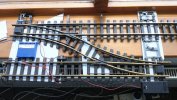And when junctions were reduced in size or complexity the old signal box would stay with the number of in use levers reduced.
I'm by experience a power person but after spending time on multi discipline projects and then managing signalling upgrade and renewal projects one tends to pick up all sorts of useless information.
If anyone tries to tell you signalling is a black art its gollywoggle, signalling is like a flow chart but with lots of different combinations of scena
Indeed they would, I think this list of colours would help understanding a little.And when junctions were reduced in size or complexity the old signal box would stay with the number of in use levers reduced.
I'm by experience a power person but after spending time on multi discipline projects and then managing signalling upgrade and renewal projects one tends to pick up all sorts of useless information.
If anyone tries to tell you signalling is a black art its gollywoggle, signalling is like a flow chart but with lots of different combinations of scena
Westinghouse Brake & Saxby Signal Co. Ltd. Lever Colours
Lever Colours. Controlled Device. Signal box.RED, STOP SIGNAL, ANY. BLACK
POINTS, ANY. WHITE
SPARE, ANY.
YELLOW, DISTANT
Copied from a webb search not very well I fear! Oh just clicked on the link and it is much more comprehensive to the above list though this will work for most of us mere mortals.



